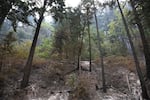
The Oregon Department of Transportation says it needs to assess an estimated 2,000 trees to see if they're at risk of falling onto I-84 as a result of the Eagle Creek Fire.
Ericka Cruz Guevarra / OPB
Oregon Republican Congressman Greg Walden introduced a bill to Congress Friday to expedite salvage and reforestation projects in the Columbia River Gorge and other National Scenic Areas after catastrophic events like the Eagle Creek Fire. That blaze, which ignited Sept. 2, is now the nation's top priority wildfire and is burning more than 33,000 acres in the Gorge.
Related: I-84 To Remain Closed For Another Week Due To Eagle Creek Fire
The bill would require the Forest Service to begin developing a cleanup and reforestation plan within 30 days after containment. It would give the Forest Service fast track authority to clean up and reforest priority areas such as municipal watersheds.
"What we’re trying to do here is clear the bureaucratic decks so that the professionals can do their job and do it quicker," Walden said at a press conference Saturday.
"This can all be done following all the environmental laws, but we’ve gotta streamline the timelines — we have to get at work here as soon as the flames are out and the basic work is done."
In 1986, President Ronald Regan signed an act that designated the Columbia River Gorge as the nation's second National Scenic Area. The act was meant to protect and designate resources to forest enhancements.
Walden, a former chairman of the House Resources Subcommittee on Forests and Forest Health, said the Gorge's status as a National Scenic Area means there are barriers to quick reforestation. That's a problem, he said, because timber with any potential monetary value could end up going to waste if crews can't begin the work of replanting burned areas quickly.
"What I hear is that if this were state land or county land or private land, the land managers would be in right away," Walden said. "Too often on our federal lands, the process is such that it could take a year or two, and by that point you've lost the value of the timber. And so you lose the financial resource that we need to be able to pay for the restoration work."
Jim Pena, the Region 6 Regional Forester with the U.S. Forest Service, said restoration in the Gorge isn't just about reforestation. Pena said stabilizing trails and roads to allow the public back in safely is a big concern.
Related: Gov. Brown Presses Federal Authorities For Resources, As Oregon Wildfires Grow
"You heard people talk about the concern about impacts to salmon, impacts to water quality, the road system in there, the trail system — those are all things we're looking at in order to restore the fire area," Pena said.
Clearer skies on Saturday revealed a mosaic of burned slopes, trees reduced to brown needles and portions where crown fires consumed foliage and tree branches. Other portions of the Gorge remain green, but trees damaged at the roots could eventually die, too.
At a Communications and Technology Subcommittee hearing Thursday, Walden named the Eagle Creek Fire when he mentioned catastrophic natural disasters in Texas, Florida and the Caribbean.
"I join those who are keeping our thoughts and prayers [with] all those affected by the hurricane and the flooding — Harvey, Irma," Walden said. "I would add to it a couple names you're not familiar with: Chetco, Indian Creek, Eagle Creek, among others, which are the fires that are ravaging the Northwest, including just a few miles from where I live."
The Oregon Department of Transportation has begun assessing at least 2,000 trees damaged by the Eagle Creek Fire. Hundreds have fallen onto the roads below, prompting ODOT to close I-84 from Hood River to Troutdale. There's no word yet on when it will reopen.
